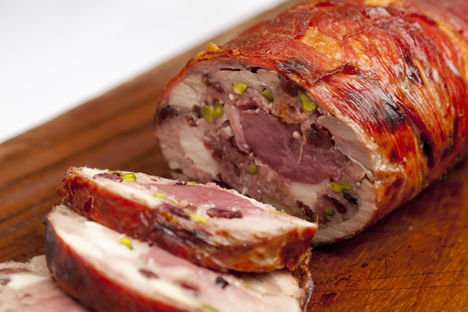
Turducken: the origins of the multi-bird roast
Known by many names, the concept of stuffing a bird within a bird within a bird is slightly unusual – but very delicious. Clare Finney explores the origins of this celebratory dish which requires some serious skill in butchery to create.
Turducken: the origins of the multi-bird roast
Known by many names, the concept of stuffing a bird within a bird within a bird is slightly unusual – but very delicious. Clare Finney explores the origins of this celebratory dish which requires some serious skill in butchery to create.
Christmas: a time of excess, celebration and overindulgence. A time for eating and drinking, not out of thirst or hunger, but for the sheer pleasure of it all. A time to see a turkey and think, why stop there? Why confine myself to one type of bird, when I can, with some ingenuity or a good butcher, eat three types, five types – hell, even seventeen types, wrapped together in a portmanteau that would make even the staunchest of vegetarians stifle a smile?
Why not a turducken? It looks like a turkey, cooks like a turkey, yet carves like a terrine. A terrine of turkey, duck, the odd bit of herby sausage stuffing, and chicken. The late Cajun chef Paul Prudhomme claimed to have invented it in Louisana in the 1970s, but his authorship seems difficult to countenance when you consider that in eighteenth century France the palace chefs were stuffing seventeen birds into each other as a matter of routine. Chinese chefs often take a variety of birds and form them into one package for grand celebrations. Even us Brits were at it: great multi-bird roasts were the height of fashion amongst Tudor landowners, being edible proof of the wealth of the household and the estate’s thriving game population. The three or four bird roast made a regular appearance at the Victorian Christmas table – Queen Victoria was said to have been a fan – whilst in fifteenth century we were stitching the head and upper torso of a pig and rooster together to create the franken-feast that is the cockentrice.
What these dishes have in common – besides all being examples of engastration, the practice of stuffing and cooking one animal inside another – is that they’re feast dishes. They’re expensive – anything from £80 to almost £200 depending on the birds’ size and number – and incredibly time consuming, taking at least forty-five minutes simply to debone and assemble. Perhaps that explains their recent return to popularity: as public interest in food, cooking and mammoth creations like those on Bake Off and MasterChef increases, the art of stuffing a chicken into a duck into a turkey or goose has taken on the aura of an ultimate feat.A proper turducken cannot be mass-produced; those seeking to buy a one ‘ready made’ will need to seek out a high-quality and highly skilled butchers, whose carcasses invariably come from organic, free-range sources. Those looking to make one themselves will need eight hours and a finger or two to spare (deboning injuries are not uncommon) along with a detailed recipe.
For butchers and farmers the three, four, ten or fifteen bird roast is a way of adding value to their stock – something Claire Symington of Seldom Seen Farm found in the early 1990s. She’s been credited with reviving the dish in Britain, together with television chefs like Antony Worrall Thompson and Hugh Fearnley-Whittingstall, who famously cooked a ten bird roast for his River Cottage Medieval Christmas Banquet. For the dinner host, they are a showstopper on a scale many could only dream of, whilst for the foodies, they provide a flavour profile to which a simple goose or turkey could never come close.


